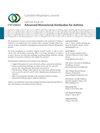Use of the Serum Level of Cholinesterase as a Prognostic Marker of Nonfatal Clinical Outcomes in Patients Hospitalized with Acute Exacerbations of Chronic Obstructive Pulmonary Disease
IF 2.1
4区 医学
Q3 RESPIRATORY SYSTEM
引用次数: 0
Abstract
Introduction. Acute exacerbation of chronic obstructive pulmonary disease (AECOPD) contributes to a poor prognosis. Reliable biomarkers to predict adverse outcomes during hospitalization are important. Aim. To investigate the relationship between the serum cholinesterase (ChE) level and adverse clinical outcomes, including hypoxemia severity, hypercapnia, duration of hospital stay (DoHS), and noninvasive ventilation (NIV) requirement, in patients with AECOPD. Methods. Patients hospitalized with AECOPD in the Wuhu Hospital of Traditional Chinese Medicine between January 2017 and December 2021 were included. Results. A total of 429 patients were enrolled. The serum ChE level was significantly lower in patients with hypercapnia, who required NIV during hospitalization and who had a DoHS of >10 days, with an oxygenation index < 300. The ChE level was correlated negatively with the C-reactive protein level and neutrophil-to-lymphocyte ratio and correlated positively with the serum albumin level. Multivariate logistic regression analysis indicated that a serum ChE level of ≤4116 U/L (OR = 2.857, 95% CI = 1.46–5.58, ) was associated significantly with NIV requirement. Conclusions. The serum ChE level was correlated significantly with complicating severe hypoxemia, hypercapnia, prolonged DoHS, and the need for NIV in patients hospitalized with AECOPD. The serum ChE level is a clinically important risk-stratification biomarker in patients hospitalized with AECOPD.使用血清胆碱酯酶水平作为慢性阻塞性肺病急性加重住院患者非致命性临床结局的预后指标
导言。慢性阻塞性肺疾病(AECOPD)的急性加重会导致不良预后。预测住院期间不良后果的可靠生物标志物非常重要。研究目的研究 AECOPD 患者血清胆碱酯酶(ChE)水平与不良临床结果(包括低氧血症严重程度、高碳酸血症、住院时间(DoHS)和无创通气(NIV)需求)之间的关系。方法纳入2017年1月至2021年12月期间在芜湖市中医院住院治疗的AECOPD患者。结果共纳入 429 例患者。高碳酸血症、住院期间需要 NIV、DoHS 为 >10 天、氧合指数为 < 300 的患者血清 ChE 水平明显较低。ChE 水平与 C 反应蛋白水平和中性粒细胞与淋巴细胞比率呈负相关,与血清白蛋白水平呈正相关。多变量逻辑回归分析表明,血清 ChE 水平≤4116 U/L(OR = 2.857,95% CI = 1.46-5.58)与 NIV 需求显著相关。结论血清胆碱酯酶水平与 AECOPD 住院患者并发严重低氧血症、高碳酸血症、DoHS 延长以及 NIV 需求显著相关。血清胆碱酯酶水平是对 AECOPD 住院患者具有重要临床意义的风险分级生物标志物。
本文章由计算机程序翻译,如有差异,请以英文原文为准。
求助全文
约1分钟内获得全文
求助全文
来源期刊

Canadian respiratory journal
医学-呼吸系统
CiteScore
4.20
自引率
0.00%
发文量
61
审稿时长
6-12 weeks
期刊介绍:
Canadian Respiratory Journal is a peer-reviewed, Open Access journal that aims to provide a multidisciplinary forum for research in all areas of respiratory medicine. The journal publishes original research articles, review articles, and clinical studies related to asthma, allergy, COPD, non-invasive ventilation, therapeutic intervention, lung cancer, airway and lung infections, as well as any other respiratory diseases.
 求助内容:
求助内容: 应助结果提醒方式:
应助结果提醒方式:


